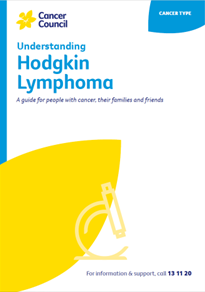- Home
- Hodgkin lymphoma
- About Hodgkin lymphoma
About Hodgkin lymphoma
Hodgkin lymphoma is a blood cancer that begins in the white blood cells called lymphocytes. It is one of the two main groups of lymphoma. The other group is non-Hodgkin lymphoma.
Learn more about:
For your community
Overview
Hodgkin lymphoma is sometimes called Hodgkin’s disease. The name Hodgkin comes from the doctor who first described this cancer. The disease usually starts in a lymph node at one or more places in the body. It can spread through the lymphatic system to other lymph tissue, particularly the spleen and bone marrow. Because the lymphatic system is a network throughout the body, Hodgkin lymphoma can appear in several parts of the body at the same time.
Sometimes, Hodgkin lymphoma spreads outside the lymphatic system to form a tumour in other organs, such as the spleen, liver or lung. This is known as extranodal disease.
What is blood cancer?
Cancer is a disease of the cells, and cells are the body’s basic building blocks – they make up tissues and organs. The body constantly makes new cells to help us grow, replace worn-out tissue and heal injuries.
Normally, cells multiply and die in an orderly way, so that each new cell replaces one lost. Cancer develops when cells become abnormal and keep growing.
When a cancer begins in abnormal blood cells, it is known as a blood cancer. The 3 main groups of blood cancers are lymphoma, leukaemia and myeloma.
Lymphoma is cancer of the body’s lymphatic system. It happens when abnormal white blood cells called lymphocytes grow uncontrollably and form a lump (tumour), usually in a lymph node.
If these abnormal lymphocytes continue to build up, they can spread through the lymph and blood vessels to form a tumour in another part of the lymphatic system or, sometimes, in an organ outside the lymphatic system, such as the liver or lung.
As the abnormal lymphocytes replace normal cells, the body’s immune system becomes less able to resist and fight infections. Sometimes other types of cancer spread to the lymph nodes. This is not lymphoma. For example, breast cancer that spreads to the lymph nodes is still called breast cancer.
How lymphoma starts
Lymphoma usually starts in the lymph nodes.
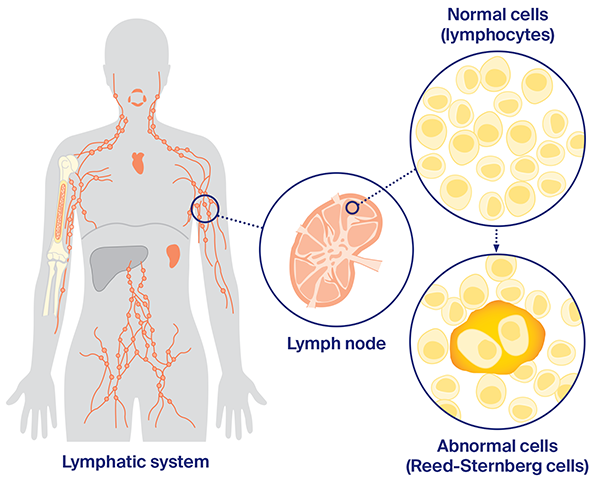
How lymphoma spreads
Lymphoma can travel through the lymphatic system (or sometimes through the blood) to other parts of the body.
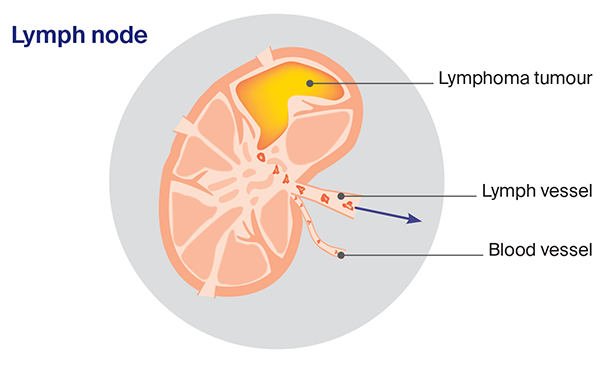
The lymphatic system
Lymph vessels – These thin tubes are found throughout the body and in organs such as the spleen, liver, thymus gland and bone marrow. Lymph vessels carry lymph fluid around the body.
Lymph fluid – This clear fluid travels to and from the tissues in the body, carrying nutrients and taking away bacteria, viruses, abnormal cells and cell debris.
Lymph nodes – Also called lymph glands, these small, bean-shaped structures are made up of lymph tissue. There are about 600 lymph nodes found in groups along the lymph vessels, including in the neck, underarms, chest, abdomen and groin. Lymph nodes filter lymph fluid before emptying most of the fluid into the bloodstream.
Other lymph tissue – As well as lymph nodes, lymph tissue is found in other parts of the body. This includes the:
- bone marrow: produces blood cells
- thymus gland: helps produce a type of white blood cell known as a T-cell
- spleen: stores white blood cells, filters waste products from the blood, and destroys old blood cells, abnormal cells and bacteria
- tonsils: trap inhaled or ingested germs
- digestive system: stores immune cells.
Parts of the lymphatic system
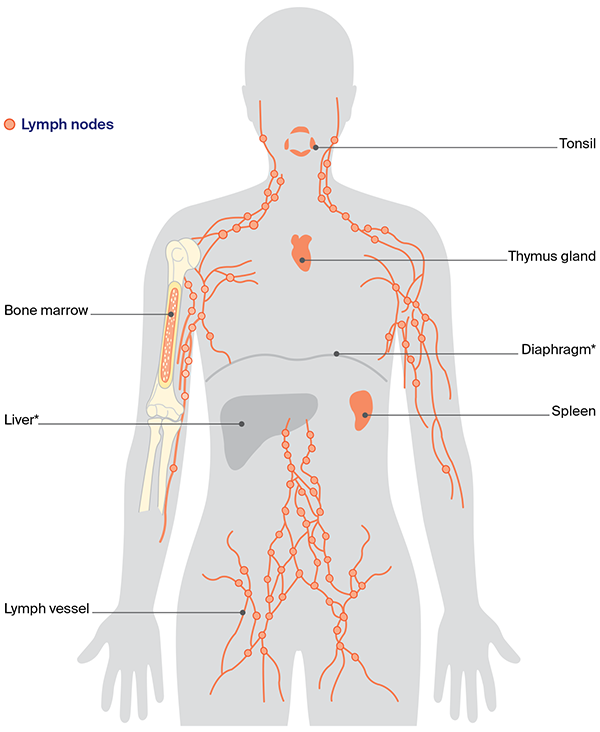
The role of blood cells
Bone marrow is the soft, spongy material inside bones. Bone marrow produces blood stem cells, which are unspecialised blood cells that usually grow into one of the three main types of blood cells: red blood cells, white blood cells and platelets. Each type of blood cell has a specific function (see diagram below).
There are different types of white blood cells. The lymph nodes, lymph tissue and lymph fluid all contain the white blood cells known as lymphocytes.
When germs become trapped in the lymph nodes, the nodes swell. Swollen lymph nodes are a sign that your body is fighting an infection. For example, the lymph nodes in your neck may swell when you have a sore throat. Swelling happens because the lymphocytes in the lymph nodes multiply to fight off the virus or bacteria that is causing the infection.
Diseases such as lymphoma or treatments such as chemotherapy can lower the number of blood cells in the body. This can cause particular symptoms:
- A low level of white blood cells (neutropenia or lymphopenia) makes you more likely to get infections.
- A low level of red blood cells (anaemia) may make you look pale and feel tired, breathless and dizzy.
- A low level of platelets (thrombocytopenia) means you bruise or bleed easily.
For more information about lymphoma, visit Lymphoma Australia, and for more on blood cancers, visit Leukaemia Foundation.
Types of blood cells
The blood contains different types of cells, which all play different roles in the body.
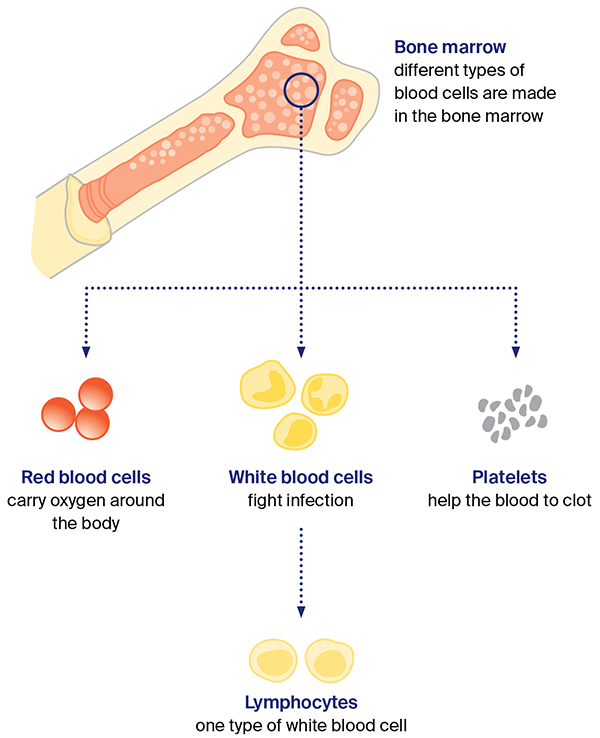
What types are there?
There are 2 main types of Hodgkin lymphoma. Classical Hodgkin lymphoma is the most common type, and nodular lymphocyte-predominant Hodgkin lymphoma (NLPHL) is rare.
These types differ in how they look under the microscope, and how they grow and spread.
Classical Hodgkin lymphoma |
NLPHL |
|
|
This information is about Hodgkin lymphoma in adults. For information about Hodgkin lymphoma in children, see childrenscancer.canceraustralia.gov.au.
Who gets Hodgkin lymphoma?
Each year in Australia, about 760 people are diagnosed with Hodgkin lymphoma. Classical Hodgkin lymphoma can occur at any age, but it most commonly develops in younger people (with almost half of cases occurring in those aged 15–39), and in people aged 60 years and over. It is slightly more common in men than women. The much rarer NLPHL mostly affects men in their 30s and 40s, and children.
What causes Hodgkin lymphoma?
The causes of Hodgkin lymphoma are largely unknown, but the risk factors include:
Weakened immune system – The risk of developing Hodgkin lymphoma is higher if your immune system isn’t working properly. This can occur if you have an autoimmune disease, such as rheumatoid arthritis or coeliac disease, or if you need to take medicines that suppress the immune system after an organ transplant.
Certain viruses – Infection with Epstein-Barr virus (the virus that causes glandular fever or infectious mononucleosis) or human immunodeficiency virus (HIV) increases the risk, but these infections are connected with only a small number of Hodgkin lymphoma cases. Most people with Epstein-Barr virus or HIV will not develop Hodgkin lymphoma.
Family history – Having a parent, brother or sister (first-degree relative) who has had Hodgkin lymphoma slightly increases a person’s risk of developing it. However, this family history link is uncommon.
Many people with known risk factors don’t develop Hodgkin lymphoma, and most people who do get it have no known risk factors. Hodgkin lymphoma is not contagious.
What is non-Hodgkin lymphoma?
There are 2 main types of lymphoma:
- Hodgkin
- non-Hodgkin.
Non-Hodgkin lymphoma is more common. The 2 types look different when the diseased cells are examined under a microscope. A type of lymphocyte called a Reed-Sternberg cell is seen in most cases of Hodgkin lymphoma, but it is not found in non-Hodgkin lymphoma.
This section is only about Hodgkin lymphoma.
For more on non-Hodgkin lymphoma, call 13 11 20 or see our general section on Non-Hodgkin lymphoma.
For an overview of what to expect at every stage of your cancer care, visit Guide to Best Cancer Care – Lymphoma. This is a short guide to what is recommended, from diagnosis to treatment and beyond.
→ READ MORE: Hodgkin lymphoma symptoms
More resources
Prof Mark Hertzberg AM, Head, Department of Haematology, Prince of Wales Hospital; Dr Puja Bhattacharyya, Haematology Staff Specialist, Western Sydney Local Health District – Blacktown Hospital; A/Prof Susan Carroll, Senior Staff Specialist, Radiation Oncology, Royal North Shore Hospital and University of Sydney; Gerry Flanagan, Consumer; Alisha Ganesh, Haematology Clinical Nurse Consultant, Concord Repatriation General Hospital; Kelly King, Cancer Council Liaison, Central Coast Cancer Centre; Ilana Krug, Social Worker – Haematology and Oncology, Gosford Hospital; Amy McGee, Consumer.
View the Cancer Council NSW editorial policy.
View all publications or call 13 11 20 for free printed copies.
